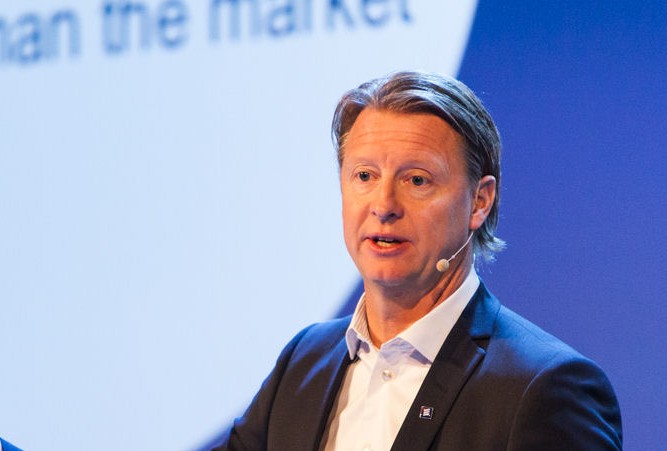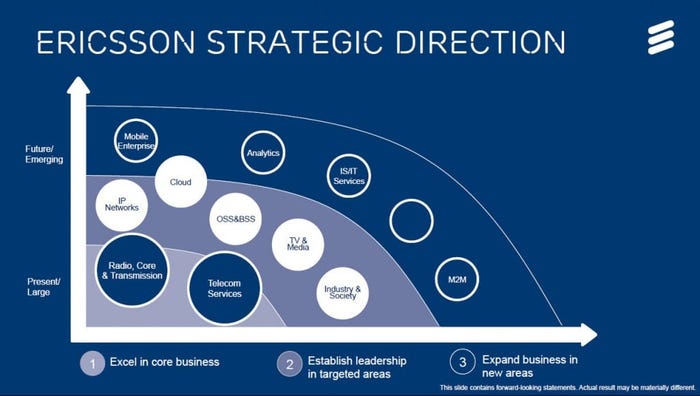Telecoms.com catches up with Ericsson CEO Hans Vestberg at the Ericsson Business Innovation Forum in Stockholm. Vestberg is keen to focus on the journey Ericsson is on to transform itself into a broad-based ICT company and to detail some of the milestones and challenges that entails.
November 26, 2014

Telecoms.com catches up with Ericsson CEO Hans Vestberg at the Ericsson Business Innovation Forum in Stockholm. Vestberg is keen to focus on the journey Ericsson is on to transform itself into a broad-based ICT company and to detail some of the milestones and challenges that entails.
“We are the clear number one in mobile infrastructure and services, and what is happening in the whole industry is the move to data and the need to transform. So then we have these five areas where we are establishing our leadership,” says Vestberg, referring to the Ericsson strategy slide below.
“They still are a little bit early for us, they’re not generating enough bottom line for us and not at the moment yielding enough growth to support the decline in our core areas, which are still the majority of our revenues.”
Having said that, Vestberg insists he’s not betting the farm on any one new area. “I’m betting the farm on mobility and services – that can never fail,” he says. “So I’m betting that I keep my core business intact and leadership, because then I can do the others. I also in a smooth way do a capital resource allocation from this area to new areas. I don’t have an unlimited budget or unlimited resources, unfortunately.”
Moving into new areas such as software, cloud, media, etc, presumably puts Ericsson in competition with companies that used to be allies, so who does Vestberg see as his new competitors?
“In our traditional area – mobile infrastructure – Huawei is our main competitor, but we are still twice the size of them when it comes to revenue,” says Vestberg. “In services, given that we’re going from installation to consulting and system integration, here we meet companies like HP, Atos, Accenture, whoever. If I talk to my guys in TV and media it’s such a fragmented market, in OSS/BSS you have Amdocs, Oracle, on IP networks you have Cisco, Juniper, ALu, so it’s very different.
“We have selected our subset, where we believe we can compete. The good thing is we don’t compete with our customers, but some companies that were once our suppliers are now our competitors, so you need to have ‘coopetition’. It’s always difficult for large companies to handle that because one part of the organisation says this is my main supplier and another says they’re my huge competitor, but you just need to handle that.”

Ericsson Has Identified Five Main Areas It Wants To Diversify Into
Vestberg agrees that Ericsson picked a good time to get out of handsets, but not that innovation has stalled in that sector. “If you look at the mobile industry over 20 years, the phone was initially an extension of the network – you couldn’t sell a network if you didn’t have phones. Then 3G and smartphones came and suddenly the device became something different, which has been on-going for 6-7 years.
“I don’t see any reason why we’re not going to see a new innovation in the next 10-15 years. I think that as the network is going to be much denser, you can do different types of things with devices. I’m not sure it’s going to be something like a smartphone, they will still exist but we will see different types of connected devices. This industry right now is 2 billion consumer products per year and it has been converged to very few vendors, so why shouldn’t there be new ones that want to be part of this large market?”
Getting out of handsets had advantages over and above leaving an incredibly competitive market, it also opened up the opportunity for new partnerships. “Suddenly, when you drop smartphones, you realise that if you are having 50 per cent of all the traffic in the world, any smartphone vendor would like to work with you to understand how the phones are working,” says Vestberg.
“So of course we’ve extended our partnership with all the handset manufacturers enormously in the last four years. I would say any smartphone vendor in the world would have their phones in our labs 6-12 months before they hit the market to test them against 4G, 4G advanced, so see that there are no bugs, because you can’t do that with just one carrier.
“Also five years ago I wouldn’t have dreamed about why I should work with Facebook, but today Ericsson has its own door into Facebook where it says ‘Ericsson’. Inside there is a 2G network, a 3G network and a 4G network, and Facebook is trying out all their apps, first on 4G then 3G then 2G.
“If you have an Android phone and you’re in India in a rural area and you get a message on the screen to update your software, you update then then the whole network goes down because you can’t do it, so you need to think about different ways of designing your products and applications. I think that one of the misperceptions in Silicon Valley is that, you take the 7.2 billion mobile subscriptions, 300 million are on 4G, but 4.5 billion have a 2G phone still, and Facebook wants to go here too.”
But let’s not forget about Ericsson’s core customer base – the operators. How does Vestberg see them continuing to grow in this new, more ICT-focused mobile market? “At Ericsson we have never previously segmented our customers,” he says. “It sounds strange but they bought the same stuff and they were the same.
“If you think about a simple network today, you have a network, you have an IP stack, you have applications and services and on top of that the devices. What we see right now is three types of operators that want to act very differently in the market. You have the ones that we call network operators, that focus just on the network and leave everything that is on top of the network. They don’t want to grow much on sales or profit and are looking for a good return on capital investment.
“Then you see another type of operator called service creators. They invest a lot in the network to make it more intelligent and are usually very involved in 3G and 4G. Also they changed all their IT infrastructure because they need to cater for different devices and data plans, and they’re going into new industries like home surveillance, healthcare and they have their own applications. They still want to grow like they did before and, of course, are a very different type of animal. And somewhere in the middle we have service enablers that don’t go into new industries but change their data plans so they can do more.”
At the core of the ICT transformation of the telecoms business is the emergence of SDN – software defined networking. Where does Vestberg think we are in that process? “Early, early, early. We are preparing all our products, we have our SDN controllers, we are proof of concept,” he says. “Some operators are more advanced than others and I think the most vocal one is AT&T, which has done the most, which we are the big vendor for them in all this. So I think that’s where we are; we’re going to see much more on this over the next five years.”
To conclude Vestberg stresses that Ericsson’s transformation is an ongoing process, but that he’s confident Ericsson is headed in the right direction. “We want to continue to be an extremely relevant player in the ICT industry; we want to continue to be number one,” says Vestberg. “That means you need to invest, you need to transform and we’re doing that to the best of our ability.”
Read more about:
DiscussionAbout the Author(s)
You May Also Like








.png?width=300&auto=webp&quality=80&disable=upscale)


_1.jpg?width=300&auto=webp&quality=80&disable=upscale)


.png?width=800&auto=webp&quality=80&disable=upscale)